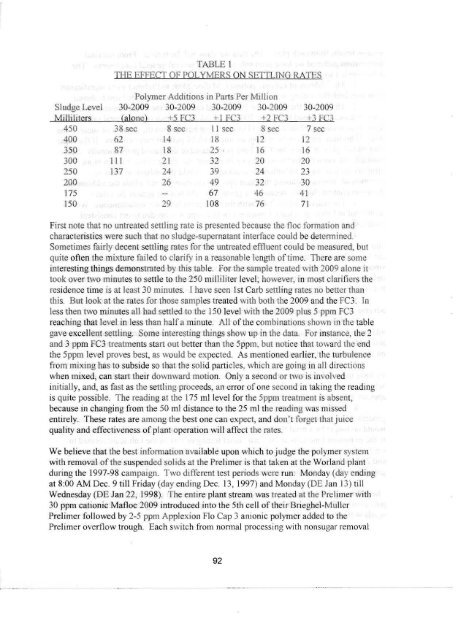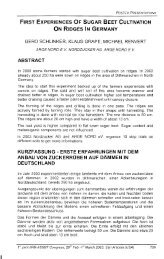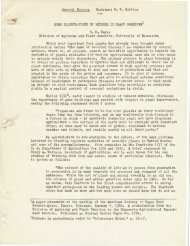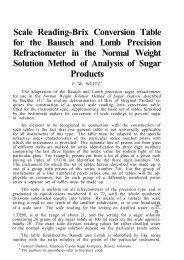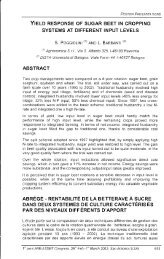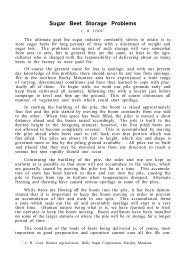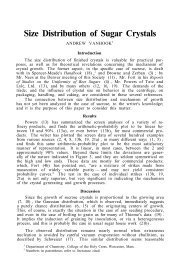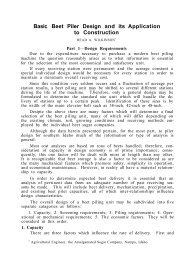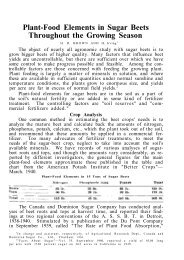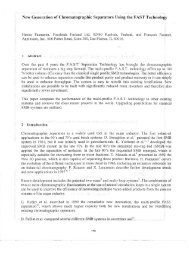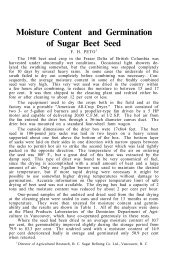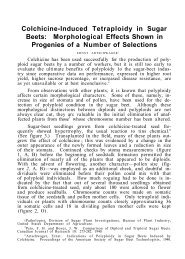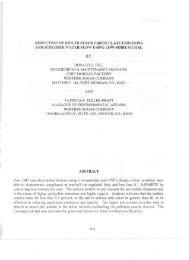Prelimer suspended solids can be separated. - ASSBT Proceedings
Prelimer suspended solids can be separated. - ASSBT Proceedings
Prelimer suspended solids can be separated. - ASSBT Proceedings
You also want an ePaper? Increase the reach of your titles
YUMPU automatically turns print PDFs into web optimized ePapers that Google loves.
TABLE 1<br />
THE EFFECT OF POLYMERS ON SETTLING RATES<br />
Polymer Additions in Parts Per Million<br />
30-2009 30-2009 30-2009 30-2009<br />
(aIQ n~ ) 5 FC3 +1 FC3 +2 Fe3<br />
30-2009<br />
+3 C3<br />
Sludge L vel<br />
Milliliters<br />
450 38 sec 8 sec 11 sec 8 sec 7 sec<br />
400 62 14 l8 12 12<br />
350 87 18 25 . 16 16<br />
300 111 2J<br />
"")<br />
j", 20 20<br />
250 137 24 39 24<br />
")"<br />
L-' <br />
200 26 49 32 30 <br />
175 67 46 41 <br />
150 29 108 76 71 <br />
First note that no untreated settling rate is presented <strong>be</strong>cause the floc formation and<br />
characteristics were such that no sludge-supernatant interface could <strong>be</strong> determined.<br />
Sometimes fairly decent settling rates for the untreated effluent could <strong>be</strong> measrrred, but<br />
quite often the mixture fail ed to clarify in a reasonable length of time. There are some<br />
interesting things demonstrated by this table. For the sample treated with 2009 alone it<br />
took over two minutes to settle to the 250 mi lliliter level; however, in most clarifiers the<br />
residence time is at least 30 minutes. I have seen 1st Carb settling rates no <strong>be</strong>tter than<br />
this. But look at the rates for those samples treated with both the 2009 and the FC3. in<br />
less then two minutes all had settled to the 150 level with the 2009 plus 5 ppm FC3<br />
reaching that level in less than half a min ute. All of the combinations shown in the table<br />
gave excellent settling. Some interesting things show up in the data. For instance, the 2<br />
and 3 ppm FC3 treatments start out <strong>be</strong>tter than the 5ppm, but notice that toward the end<br />
the 5ppm level proves <strong>be</strong>st, as would <strong>be</strong> expected. As mentioned earlier, the turbuJence<br />
from mixing has to subside so that the solid particles, which are going in all directions<br />
when mixed, <strong>can</strong> start their downward motion. Only a second OT two is involved<br />
initially, and, as fast as the settling proceeds, an error ofone second in taking the read1l1g<br />
is quite possible. The reading at the 175 ml level for the 5ppm treatment is absent,<br />
<strong>be</strong>cause in changing from the 50 ml distance to the 25 ml the reading was missed<br />
entirely. These rates are among the <strong>be</strong>st one <strong>can</strong> expect, and don' t forget that j ulce<br />
quality and effectiveness of plant operation will affect the rates.<br />
We <strong>be</strong>lieve that the <strong>be</strong>st information available upon which to j udge the polymer system<br />
with removal of the <strong>suspended</strong> <strong>solids</strong> at the <strong>Prelimer</strong> is that taken at the Worland plant<br />
during the 1997-98 campaign. Two different test periods ere run: Monday (day ending<br />
at 8:00 AM Dec. 9 till Fr iday (day ending Dec. 13, 1997) and Monday (DE Jan 13 ) till<br />
Wednesday (DE Jan 22, 1998). The entire plant stream was treated at the <strong>Prelimer</strong> with<br />
30 ppm cationic Mafloc 2009 introduced into the 5th cell of their Brieghel-Muller<br />
<strong>Prelimer</strong> followed by 2-5 ppm Applexi on Flo Cap 3 anionic polymer added to the<br />
<strong>Prelimer</strong> overflow trough. Each switch from nonna} processing with nonsugar removal<br />
92


